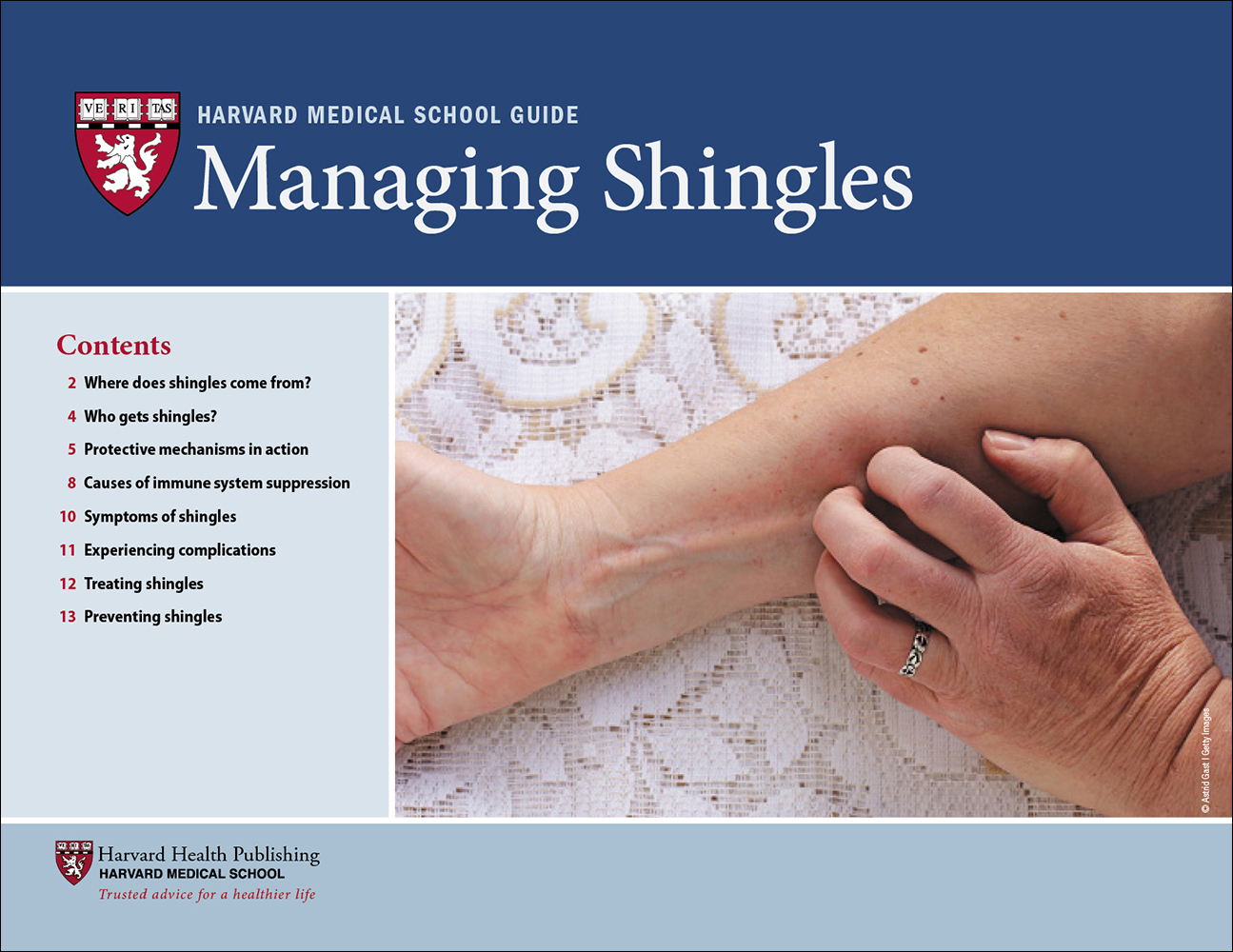Harvard Health Blog
Shingles of the eye can cause lasting vision impairment

Shingles, or herpes zoster, is a viral infection known for its characteristic painful, burning, or itchy rash. This rash appears along a particular affected nerve, for example in a band on one side of the chest or abdomen that extends around to the back. In fact, the name shingles comes from cingulum, the Latin word for girdle, belt, or sash.
Shingles is caused by reactivation of the varicella zoster virus, the virus that causes chickenpox. After the initial chickenpox infection resolves the virus lives on in nerves all over the body, but is kept in check by the immune system. The risk of shingles therefore increases with any process that can weaken the immune system, including age, illness, and immune-suppressing medications. About one million cases of shingles occur in the US each year.
Up to 20% of shingles episodes involve nerves of the head, where the infection can affect various parts of the eye, including the eyelid, the eye surface, and the deeper portions of the eye. Viral infection of the eye can cause pain, drainage, redness, and sensitivity to light. In some cases it can lead to vision impairment, including blindness.
Shingles in the front of the eye
Shingles can affect the cornea, the curved, transparent dome of tissue at the front of the eye. This is called keratitis, and it can occur as a complication of herpes zoster ophthalmicus (HZO), which refers to shingles with a rash that typically involves one side of the upper face, forehead, and scalp. More than half of patients with HZO may have keratitis.
If you have shingles involving the upper face, forehead, or scalp area, it is important to see an ophthalmologist for a formal eye examination, whether or not you notice any eye symptoms. Keratitis usually develops within one month of the shingles rash and can lead to numbness of the cornea, scarring, additional infections, and more corneal damage, which can ultimately cause blindness.
HZO, like episodes of shingles on other areas of the body, is typically treated with oral antiviral medications to address the underlying viral infection. Treatment decreases the risk of later eye complications by about 40% to 60%. When started within 72 hours of the onset of symptoms, antiviral treatment also reduces the overall severity of the infection and the risk of post-herpetic neuralgia, a form of long-term pain that can occur after an episode of shingles.
Shingles in the back of the eye
Shingles involving the retina or optic nerve — structures found at the back of the eye — typically is not associated with a skin rash or other symptoms at the eye surface. This type of shingles infection is called viral retinitis and occurs much less commonly than HZO. But it can significantly damage the retina through a combination of infection and inflammation. Viral retinitis can take the form of acute retinal necrosis (ARN) or progressive outer retinal necrosis (PORN).
In contrast to patients with HZO or other forms of shingles that are associated with a skin rash, patients with ARN are often middle-aged and generally healthy. Diagnosis of ARN requires a careful eye exam by an ophthalmologist, and a sample may be collected from the inside of the eye for testing to confirm that the infection is caused by the varicella zoster virus. In mild cases, ARN can be treated with oral antiviral medications, with or without injections of antiviral medications into the eye. In more severe cases, or if there is no improvement with oral medications and intraocular injections, these infections are treated with intravenous (IV) antiviral medications until the infection starts to improve.
Fortunately, PORN is rare. It typically occurs in people who have severely compromised immune function, and progresses rapidly. PORN is treated aggressively, with intraocular injections and IV antiviral medications.
Often for patients with shingles, including those with HZO or ARN, efforts are made to strengthen the immune system until the infection is under control. For people taking immune-suppressing medications, this may mean decreasing the dose, or allowing time for the infection to respond to antiviral treatment before administering another dose of immune-suppressing medication. Sometimes the inflammation associated with shingles of the eye is so severe that steroids are needed to control the inflammation before it damages the eye.
Shingles vaccine is the best prevention
The best way to prevent shingles, including shingles of the eye, is with a shingles vaccine. The Zostavax live shingles vaccine is no longer used in the US. Shingrix is a newer, more effective, and non-live shingles vaccine. Shingrix is a two-dose vaccine recommended for adults over age 50. It is more than 90% effective at preventing shingles. Unfortunately, the shingles vaccine does not treat shingles or post-herpetic neuralgia; the vaccine is effective only as a prevention strategy.
About the Author

Miriam Barshak, MD, Contributor
Disclaimer:
As a service to our readers, Harvard Health Publishing provides access to our library of archived content. Please note the date of last review or update on all articles.
No content on this site, regardless of date, should ever be used as a substitute for direct medical advice from your doctor or other qualified clinician.
















